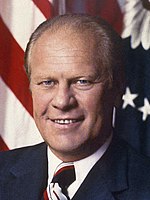
Back Bestätigung des Vizepräsidenten der Vereinigten Staaten 1973 German 1973年アメリカ合衆国副大統領承認 Japanese
| ||||||||||||||||||||
100 and 435 members of the Senate and House Majority of both Senate and House votes needed to win | ||||||||||||||||||||
|---|---|---|---|---|---|---|---|---|---|---|---|---|---|---|---|---|---|---|---|---|
| ||||||||||||||||||||
 Vote by house district Republican "Aye"
Democratic "Aye"
Democratic "No"
Absent/Not voting | ||||||||||||||||||||
| ||||||||||||||||||||
| ||
|---|---|---|
|
Pre-vice presidency
40th Vice President of the United States
38th President of the United States
Policies
Appointments
Tenure
Presidential campaign Post-presidency
 |
||
On October 10, 1973, Vice President Spiro Agnew (a Republican) was forced to resign following a controversy over his personal taxes. Under the terms of the Twenty-fifth Amendment to the United States Constitution, a vice presidential vacancy is filled when the president nominates a candidate who is confirmed by both houses of Congress. President Richard Nixon (a Republican) thus had the task of selecting a vice president who could receive the majority support of both houses of Congress, which were then controlled by the Democrats.
President Nixon considered selecting former Texas Governor and Treasury Secretary John Connally, New York Governor Nelson Rockefeller, and California Governor Ronald Reagan.[1] However, Nixon settled on House Minority Leader Gerald Ford of Michigan, a moderate Republican who was popular among the members of Congress (in both parties) and who was good friends with Nixon.[1] Ford won the approval of both houses by huge margins, and was sworn in as the 40th vice president of the United States on December 6, 1973.[1][2]
On August 9, 1974, Ford ascended to the presidency after the Watergate scandal led to the resignation of President Nixon, becoming the only president in American history to have never been elected president or vice president.[a]
- ^ a b c Mieczkowski, Yanek (April 22, 2005). Gerald Ford and the Challenges of the 1970s. University Press of Kentucky. pp. 11–13. ISBN 0813172055. Retrieved October 5, 2015.
- ^ Woodward, Bob (December 29, 2006). "Ford, Nixon Sustained Friendship for Decades". Washington Post. Retrieved October 5, 2015.
Cite error: There are <ref group=lower-alpha> tags or {{efn}} templates on this page, but the references will not show without a {{reflist|group=lower-alpha}} template or {{notelist}} template (see the help page).

